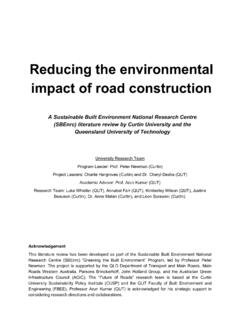Transcription of Strengths, Weaknesses, Opportunities and Threats of ...
1 Strengths, Weaknesses, Opportunities and Threats of Manufactured Buildings A Sustainable Built Environment National Research Centre (SBEnrc) Research Report University Research Team Program Leader: Prof. Peter Newman (Curtin) Project Leaders: Jemma Green and Karlson Charlie Hargroves (Curtin) Researchers: Kuntal Datta and Jessica Bunning (Curtin) Acknowledgement The report has been developed as part of the Sustainable Built Environment National Research Centre (SBEnrc) Greening the Built Environment Program, led by Professor Peter Newman. The project is supported by the Western Australia Building Commission, Western Australian Department of Treasury, Hickory Group, and CIMC.
2 The research team is based at the Curtin University Sustainability Policy Institute (CUSP). Citation: Datta, K., Bunning, J., Green, J., and Hargroves, K., (2014) Review of the Strengths, Weaknesses, Opportunities , and Threats of Manufactured Buildings for the Sustainable Built Environment National Research Centre, Curtin University Sustainability Policy Institute. PAGE ii Contents 1. Introduction ..1 A focus on innovation ..1 The industrialisation of the building sector ..2 Key focus of this research ..2 Clarification of terminology ..4 Are manufactured buildings appropriate for Australia? ..5 Manufactured building in Australia ..6 2. SWOT analysis of building manufacturing.
3 9 Strengths of building manufacturing ..9 Cost reduction ..9 Productivity ..10 Quality ..10 Environmental performance (waste reduction, energy efficiency, land use) ..11 Supply Chain Management (SCM) ..12 Health and safety ..13 3. Weaknesses of building manufacturing ..14 Capacity building ..14 Perceptions about manufactured building systems ..14 Process and people ..15 4. Opportunities of building manufacturing ..17 Need for affordable housing ..17 Job creation ..17 international competitiveness ..17 Contribution to sustainability ..18 Capture first mover Financing ..18 Increase in natural disasters ..20 Growth in market for new building products ..20 Cross Laminated Timber (CLT) and Steel ..21 PAGE iii 5.
4 Threats to building manufacturing ..23 Negative attitudes ..23 Finance ..23 High initial start-up cost ..23 Competition, market trends and geographical location ..24 Reduced demand for traditional trades ..24 Not getting stuck at the compliance/permit stage..25 6. Conclusion ..27 PAGE 1 1. Introduction A focus on innovation Manufactured housing practices date back nearly a century with the first housing construction production line being created in the United States in 1926,1 followed by the UK post World War II,2 and Japan in More recently, in 2012, the output of the prefabricated building industry globally has been estimated to be at US$ billion, with the largest regional market being Asia-Pacific valued at US$ billion, followed by Europe valued at US $ billion and North America valued at US$ Despite the popularity and growth of manufactured housing globally, the uptake in Australia is still comparatively small at 3%5 of the global market.
5 However, the industry aspires to achieve a 10% growth in the residential sector by This report looks at the relative strengths and weaknesses of different types of manufactured housing and explores the barriers and challenges to the industry being further developed in Australia. The research investigates the current level of innovation in the manufactured building industry considering both the product and the process. The findings in the report provide a SWOT analysis (Strength, Weakness, Opportunities and Threats ) of manufactured buildings. The aim of this research is to present a balanced assessment of SWOT factors to inform consideration of increasing the uptake of manufactured buildings as a potential housing sustainability option (including economic, social and environmental outcomes) in Australia.
6 The SWOT analysis also considers the following: 1) Analysis of the strengths and weaknesses by looking at real life examples of successes and failures; 2) Provision of a gap analysis of metrics, which is required to fully understand the performance of the manufactured housing industry; 3) Evaluation of the perceptions of people in the construction industry about manufactured buildings, those both directly and indirectly involved in the construction industry; 4) Performance statistics for manufactured housing related to value-adding factors such as time, cost, quality and long-term sustainability benefits of manufactured building systems and; 5) Identification of practical solutions for stakeholders such that the industry can innovate and grow to its fullest potential.
7 In Australia, the idea of manufactured building is not new. The first set of portable iron clad homes constructed in the UK, were transported to Melbourne by ship in the 1850s however, the major leap in the area of prefabricated construction took place after World War The current focus of the Australian market is on building elements such as roof trusses, window fittings, and prestressed concrete slabs. When looking for ideas on how to inform the expansion of the manufactured building industry in Australia, one place to look could be the technological and innovative advances made by the PAGE 2 aerospace, shipbuilding, and automotive industries, where industrialised processes have improved the efficiency and quality of the Another place could be the challenges faced by the manufactured building industries in Great Britain and Sweden in the 60s and 70s, where the focus was on mass production rather than on improving customer-orientation and process management (design, production and information sharing)
8 , resulting in poor Finally, the industry could look at the substantial benefits available to customers and the market to effectively increase demand. From the occupant s perspective, standardising the construction process can satisfy any number of definitions of value. For example, a balance of lower time, optimum cost and higher quality can be achieved with due attention given to the whole life cycle assessment. The social acceptability of prefabrication and standardisation in relation to new housing 10 In order for customers to realise this value, they may need to better understand the features of manufactured buildings, and what value they actually add. Hence, it will be important to adopt a consumer-oriented approach that can demonstrate clear value for customers at the design phase in order to increase the uptake of manufactured buildings.
9 The industrialisation of the building sector A wide array of parameters been used by different prefabricated companies/projects and these are analysed in this report to showcase their success and failure factors over conventional industries. Although the practices applied are different, a universal model of practices for manufactured buildings can be developed. Key focus of this research A key focus of this industry led research project for the Sustainable Built Environment National Research Centre (SBEnrc) is on investigating and compiling evidence relating to the performance of manufactured buildings. The intention is to inform those that are, or are looking to become active in the area of manufactured building.
10 This will be complimented by an analysis of existing manufacturing methods and processes (such as the model shown in Figure A) and how these could be used for the expansion of the manufactured buildings sector in Australia. Figure A: The evolution of discrete assembly manufacturing11 PAGE 3 If the construction industry wants to become more efficient and productive it will need to learn new processes. When considering the potential for processes such as those shown in Figure A, it becomes clear that a manufacturing approach to building construction can: - Harness economics of scale12 to achieve cost reductions with multiple buildings manufactured on a single site allowing benefits such as efficient inventory management, and reducing the defects, transportation costs, and time delays associated with onsite construction.


